Author: Adam Simmons
Last updated: January 7th 2024
Table of Contents
What are they?
OLED monitors are flat computer displays which consist of pixels made from OLEDs (Organic Light Emitting Diodes) rather than liquid crystal filled units. Unlike LCD (Liquid Crystal Display) technology, OLED does not require backlighting to function. The principle of this technology is that when current flows between a cathode and an anode, an emissive layer of organic molecules (e.g. polyaniline, green in diagram) sandwiched between these electrodes can become illuminated (electroluminescence). For this to happen efficiently, a layer known as the conductive layer (orange in diagram), made up of organic plastic molecules such as polyfluorene, lies between the emissive layer and the anode. The anode is positively charged and therefore draws electrons from the conductive layer, leaving the conductive layer with a positive charge that draws electrons from the emissive layer. Light is emitted as a by-product, in a process known as electrophosphorescence. The OLED process is explained in the diagram below.
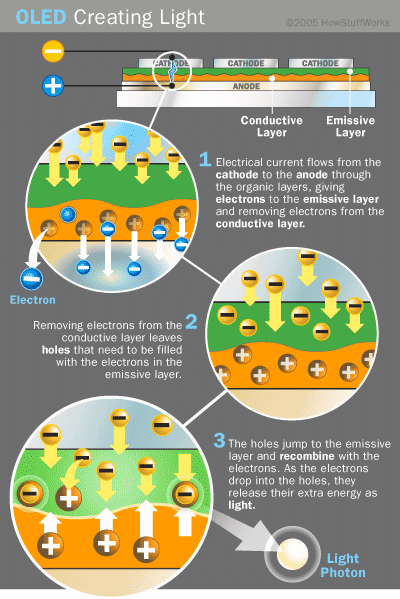
OLED process diagram (credit: HowStuffWorks)
The layers described above total a thickness of around 100-500 nanometres, which is around 100 times thinner than human hair. This makes them extremely fragile and hence they must be supported by an additional substrate layer. This substrate is usually clear plastic, foil or glass of varying thickness, and must be transparent, like the anode, so that the emitted light can be seen on the screen. The layering of an OLED cell can be seen below:
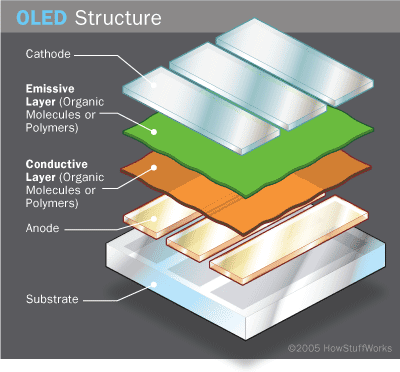
OLED cell diagram (credit: HowStuffWorks)
The colour of light emitted from the emissive layer depends on the exact organic makeup of the molecules within. As with LCD (liquid crystal display), OLED units are made up of ‘pixels’ of different colours; i.e. various organic molecules make up ‘pixels’ within the emissive layer which will emit light of different colours once illuminated. The brightness (light intensity) of an OLED is proportional to the current applied to the cell. There are several types of OLED cells which are being developed for possible incorporation into OLED monitors. The principles used in all are similar to those explained above, but the arrangement of the layers within the cells and the exact materials used differs slightly. Some technologies described below are not applicable to PC monitors and will be restricted to specialist applications such as heads-up-displays on aircraft or small bright clock screens; but we explore them anyway. Passive-matrix OLED (PMOLED) screens consist of cells with opaque cathodes and transparent anodes laid perpendicular to one another in strips. Between these strips are the organic layers of alternate coloured light-emitting diodes and conductive molecules. Once power is switched on to external circuitry (voltage is applied), current flows through particular cathode and anode strips, so that light of selected colours and brightness are emitted through the electrode intersections according to the molecules illuminated and current applied (respectively). The PMOLED process is shown diagrammatically below, with only two pixel colours shown for simplicity: Active-matrix OLED (AMOLED) screens are currently receiving massive research and development funds from the likes of Samsung, LG and Sony for incorporation into HDTVs and PC monitors. AMOLED cells contain organic molecule layers and anodes arranged in small sheets (pixels), sandwiched between a larger cathode sheet and integrated into a TFT (thin film transistor) matrix. The TFT matrix not only acts as the supporting substrate; it also controls which pixels become activated by switching on or off current flow to the appropriate pixels and hence drives them in a similar manner to TFT LCD monitors. The typical layout of such a cell is shown below, again with only two pixel colours for diagrammatic purposes. Note that the cell featured in the diagram is bottom-emitting (i.e. has a transparent TFT backplane that light passes through). AMOLED cells may also be top-emitting, meaning that light passes through a transparent cathode rather than the substrate (TFT backplane), which is reflective or transparent. Because TFT matrices are more efficient than the external circuits of PMOLED displays, AMOLED is extremely energy efficient in comparison. The TFT array controls current very rapidly and accurately, and is not held back by liquid crystals; Active Matrix OLED screens therefore have exceptional response times and colour reproduction. Although AMOLED is potentially useful for monitors and TVs, there are several additional technologies which have rather particular specialist applications. Transparent OLEDs (TOLEDs) make use of a transparent cathode in addition to the already transparent anode and substrate to produce a screen that is over 80% as transparent as the substrate used, when the pixels are in the off state. Although this could potentially be used in high-end displays (that you can literally see through), this application is limited by the inability of the TOLED matrix to display ‘black’. Nonetheness; this has particularly interesting applications in the military in aircraft, vehicle and soldier-mounted HUDs (heads-up displays). By using a highly flexible substrate, such as thin foils or plastics, it is also possible to make a durable, lightweight and even foldable OLED screen (FOLED). These have interesting applications for both civilians and military personnel, as they have be integrated into clothing. Another emerging technology involves the use of ‘pure’ white OLEDs as an efficient lighting alternative. The light emitted is more energy-efficient, brighter and whiter than fluorescent or incandescent light bulbs. By producing OLEDs in large sheets, which is an advantage of the current ‘printing’ manufacturing process, it is possible to make large thin sheets of light for use on walls and ceilings. It is even possible to make them transparent so that they could act as windows during the day and lights during the evening – perhaps even allowing them to black out. In 2009 and into 2010, a great drive has been made by PC monitor and TV manufacturers (in particular LG and Samsung) to replace the usual CCFL (Cold Cathode Fluorescent Lamp) backlights of LCD monitors with LED backlights using either white or coloured arrays. The predominant modern form of this backlight uses strips or clusters of white LEDs behind the edges of a monitor – a backlight typed dubbed WLED. A WLED backlight is lighter, thinner and more efficient than a CCFL-backlight but have until recently been very limited in their colour gamut output. OLED technology is the next step in the evolution of the display, as it does away with the backlight entirely. With only a thin transparent film in the way of the light emitted by the pixels, you get an image with previously impossible contrast, greater apparent brightness and vivid, lifelike colours with an exceptionally wide gamut. Response times and refresh rates are also significantly enhanced over even the best LCDs – an OLED monitor could theoretically have a response time of around 0.01ms and a refresh rate exceeding 1KHz (1000Hz). Manufacturers are also experimenting with multiple emissive layers to enhance the brightness, which is possible due to the exceptionally thin nature of the cells. The end result of all this is images that are much more vivid and lifelike than anything produced by an LCD. No picture or video could ever do these changes justice but this one gets the point across quite nicely. Not only is the hypothetical OLED monitor exceptionally thin and light, by doing away with the backlight you also save a tremendous amount of power; when these hit the mass-market they could be over 10 times as efficient as the best LED-backlit LCD monitor of today. As the technology stands at the moment they are considerably more efficient than LCD screens of comparable size when displaying mainly blacks and dark colours – but a lot of white on screen drives current power consumption up significantly. One undeniable advantage of is viewing angles that are vastly superior to any LCD display; light is emitted directly from the emissive layers of OLED displays. LCDs of any panel type have varying degrees of contrast and colour shift to the picture which increases at steeper viewing angles. Even IPS-type panels, the strongest performers in LCD form, show shifts which OLED panels are free from. Although not necessarily widely applicable to larger screens, OLEDs can also be flexible and/or transparent. This allows them to be used for certain specialist applications as explored in the previous section. The largest problem facing manufacturers is that organic materials used in OLED displays degrade over time, like any organic matter. The most troublesome element of this degradation is that blue-emissive pixels degrade more rapidly than their red and green counterparts. This could potentially lead to colour balance issues over time and is of great concern for PC monitors due to how frequently they would be used (unlike a small smartphone screen, for example, which spends most of its time on standby). There are also concerns over image retention and ‘burn in’. This is where static content is displayed for an extended period of time and can be seen as an ‘afterimage’ for a while (image retention) or permanently (burn in) even when the content displayed should have changed. For frequently changing content (i.e. TV viewing, video content, gaming) this isn’t generally of such concern, but for desktop PC usage it certainly is. Great strides have been made by Samsung and partners to increase the lifetime of OLED pixels of all colours. By using improved technology to ‘spray’ organic materials onto the substrate surface and by using slightly different molecules, it is thought that the lifetime of ‘blue’ pixels could be extended from 14,000 hours to 60,000 hours (nearly 7 years). This would mean that all pixel colours would degrade at similar rates and would give the monitor a useful life of several years. This same spraying process should reduce manufacturing costs (a large problem for OLED screens today) by reducing wasted materials and the completion of important and expensive research. A recent ‘spraying’ process referred to as ‘solution coating technology’ has been developed by DuPont and is showing great improvements in key areas including manufacturing efficiency and material longevity. In November 2011 DuPont signed an agreement to allow panel manufacturers such as Samsung to adopt their solution coating process commercially which is a very important step indeed. Scientists in Michigan have also been looking at increasing the lifetime of the blue OLED substrate my taking a different approach. According to Kieffer (the lead researcher), by re-configuring the molecular structure itself it should be possible to significantly extend the useful lifetime of blue substrates – effectively ‘doubling’ their efficiency. These are just examples of important research which could one day overcome the hurdles placed before the commercially viable monitor. During various trade shows Sony and Panasonic unveiled some prototype large OLED displays with 4K (4096 x 2160) resolutions. These use a technology called ‘Super Top Emission’ which incorporates an RGB pixel design and colour filters. The company claims this enhances colour purity and overall efficiency. However; they currently favour the use of LG Display’s panels, described below. Sony is also pushing out a number of professional monitors using this technology. Samsung hoped to become a dominant force when it came to such technologies, with a number of models shown off at various events and now released into the market. It hasn’t all been plain sailing, however. They have been suffering from a number of issues such as yield and production prices with their ‘Super Top Emission’ technology and had scrapped plans to build a new manufacturing plant for large OLED displays. For TVs and small panels released so far, Samsung has favoured ‘conventional’ RGB OLED design (dubbed ‘Super-OLED’) with direct colour light emission from its organic subpixels. It is worth noting that they have manufactured 13″-14″ OLED panels that have been used in a number of notebooks and tablets designed to run Windows (including a Dell Alienware model). Companies such as Samsung have also put in a lot of research and development effort into RGB OLED applied using an inkjet printing method. They see this application process as particularly useful in the production of monitor panels, as covered in this piece (requires translation from Korean) published December 2018 in ET News. The other good news for the consumer is that LG Display have recently massively increased their investment in such technology and are really ramping up their production capacity. RWBG (sometimes inaccurately referred to as WRGB) OLED is LG’s current preferred method. As far as models for consumer use LG have a number of large displays (TVs or monitors using ‘TV panels’) on the market which use a colour-filtered RWBG design, some of which are also curved. RWBG is essentially an evolution or sub-category of WOLED (White OLED), featuring colour filters over three organic white subpixels (like traditional WOLED designs) with a fourth subpixel that emits ‘naked’ unfiltered white light. This is designed to enhance the luminance efficiency compared to an RGB OLED or traditional WOLED design with the white pixel able to assist in brightening the image or displaying pure white on its own. As with other implementations this system benefits from luminance control on a per-pixel basis, allowing a pretty much infinite contrast ratio to be achieved. The potential colour gamut is certainly restricted when compared to an RGB OLED design. And so is the colour volume, with saturation levels reduced at high brightness due to the dilutive effect of the unfiltered white subpixel. In terms of solid products for the ‘mainstream’, a 30″ OLED monitor was available for a short period – the Dell UP3017Q. This iteration of OLED is popular for larger panels in the TV market, with some manufacturers dipping their toes into using TV-sized OLED panels for monitors as well. With 42″+ offerings available or announced from various manufacturers, such as the ASUS PG42UQ and lower resolution ultrawide alternatives such as the LG 45GR95QE and Corsair Xeneon Flex (45WQHD240). LG plans to expand production to include ‘mid-size’ RWBG OLED panels in the ~27″ – 32″ size range. The first model which features such a panel is the LG 27GR95QE, with models from other manufacturers which share the same panel. Other exciting developments came from JOLED, a Japanese joint venture between Sony and Panasonic’s OLED display divisions. Their initial pilot panel was a 21.6″ RGB OLED designed primarily for medical purposes and high-end monitors, such as the ASUS PQ22UC. JOLED moved onto mass-produced panels in monitor sizes of up to 32″, using a technology dubbed ‘TRIPRINT’. Such panels have been used in their own ‘OLEDIO’ line and in products such as the LG UltraFine OLED Pro series and ASUS PA32DC. These are 60Hz models focused on colour-critical workloads. Such models fetch a significant premium ($3000+) as the JOLED panels used are specialised high-end parts produced in relatively low volumes – certainly compared to the scale of many LCD panels. Expansion appeared to be going well for the company, with other monitor manufacturers on board and a continuing drive downwards in product cost. As a later update in that thread confirmed, though, they appear to have been unable to secure the funding they need to expand or potentially even continue with their business and have now filed for bankruptcy. AU Optronics is also getting into the inkjet-printed OLED panel game, with plans for 32″ 144Hz ‘4K’ UHD panels. Note: QLED (Quantum-dot Light Emitting Diode) has been coined by Samsung to refer to solutions that use Quantum Dots in place of phosphors for LED backlights, as described in this article. This would more correctly be termed QD LED, QD Film, Quantum Dot Enhancement Film (QDEF) or something more specific related to the exact technology. Using Quantum Dots (QDs) as a light source rather than to replace the phosphors in LED backlights is an equally exciting technology. This could bring similar advantages to OLED, without the same concerns about material degradation or brightness limitation. Whilst also allowing greater colour gamut coverage to be achieved due to the exceptional purity of light emitted. This is a complete non-organic alternative to OLED – with self-emissive pixels bringing with it similar key advantages to RGB-OLED designs. You can get a broad perspective of the principles behind ‘QLED displays’ on Wikipedia. Quantum Dots are a far-reaching nanotechnology with many useful applications aside from those involving displays. A lot of initial work in this field that would apply to TVs and monitors was borne of a partnership between QD Vision and LG Display. In addition to sharing or building on the advantages of OLED, such as exceptional contrast and colour gamut support, there were a number of other claims initially made by QD Vision. These include; superior energy efficiency (100% better claimed), higher luminance (30-40% greater claimed) and better stability (read: longer lifetime). Back in 2011 MIT Technology review reported a ‘significant step’ towards the demonstration of Quantum Dot display technology for practical purposes. They reported that researchers at Samsung had produced a 4-inch ‘full colour’ monitor. This may not seem like much but it was the first screen to combine red, blue and green subpixels – a solution that could potentially be scaled up to much larger devices (such as computer monitors). The article ended with a few words to inject some further reality to the situation as it was back then. It was a technology that lagged behind OLED in terms of efficiency and there were obstacles related to lifetime still needed to be overcome. This is why Quantum Dots have instead been incorporated into a backlight for existing LCD designs. Now, it seems things are moving forwards nicely. As we mentioned earlier, there are serious concerns with respect to organic material lifetime and degradation – even with current improvements in manufacturing processes. These concerns, coupled with unacceptably high production costs, are sufficient for Samsung to have switched their longer term focus away from relying solely on organic materials for red, green and blue light emission. They have also pivoted away from LCD panel production, with their new technology focus being to use a layer of red and green QDs with a blue OLED ‘backlight’ (per-pixel illumination). A sort of hybrid solution sometimes referred to as ‘QD-OLED’, ‘Quantum Dot OLED’, or ‘QD-Display’. This technology retains many advantages of both technologies and is hopefully scalable for monitor-sized panels. The video below, courtesy of Nanosys and Samsung Display, takes a look at QD-OLED. It covers areas such as the makeup of QD-OLED and their subpixels – with multiple blue OLED layers excited by red and green QDs (via phospholuminescence) – plus lifetime expectations and performance characteristics. Nanosys, who have been tremendously successful at integrating Quantum Dots into existing LCD displays, are working towards QDEL (Quantum Dot Electroluminescent) technology; now referred to as ‘NanoLED’ to make it more distinct from the likes of Samsung’s ‘QLED’. This is the ‘pure’ QD solution described above which uses red, green and blue Quantum Dots in a self-emissive display. An early prototype was demonstrated at CES 2023. We have high hopes for this technology and will continue to bring you news on further advancements in this exciting field of monitor technology as soon as we can. As an Amazon Associate I earn from qualifying purchases made using the below link. Where possible, you’ll be redirected to your nearest store. Further information on supporting our work.
As an Amazon Associate I earn from qualifying purchases made using the below link. Where possible, you’ll be redirected to your nearest store. Further information on supporting our work.

Types of OLED screen
Passive-matrix
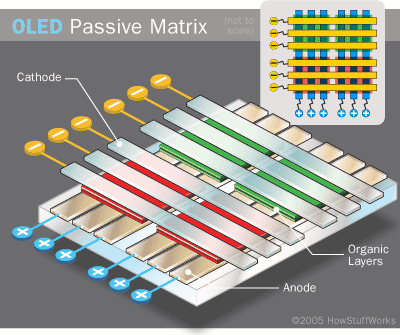
PMOLED cell (credit: HowStuffWorks)
Active-matrix

AMOLED cell (credit: HowStuffWorks)
Other OLED technologies
The advantages
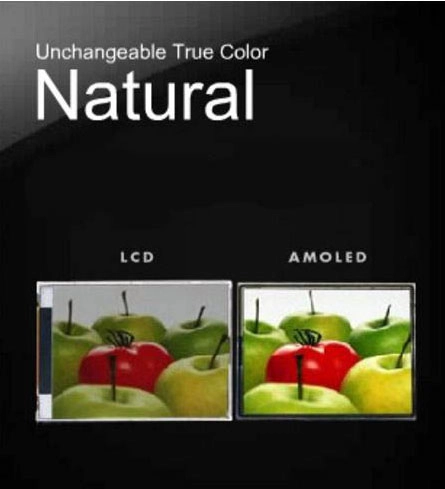
OLED image quality
The disadvantages
Advancements in OLED
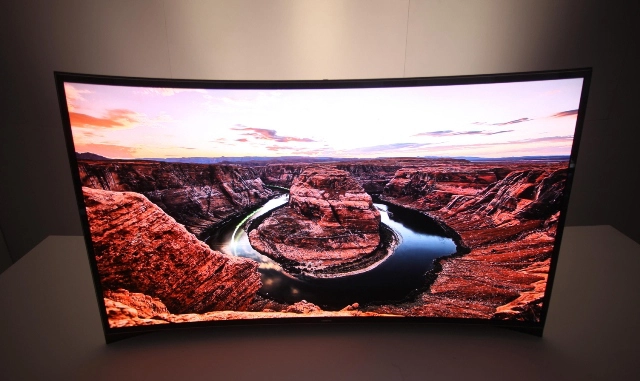
Samsung curved OLED TV
Quantum Dots – a non-organic alternative

Quantum Dots - an alternative


